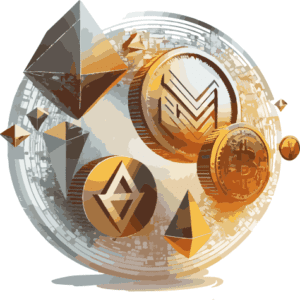You’ve heard of Bitcoin and Ethereum, the titans of the crypto world. But did you know there’s a second layer to this universe that could revolutionize how we transact and interact?

Welcome to the fascinating realm of Layer 2 solutions—where scalability meets efficiency. Stick around; you won’t want to miss this deep dive.
What Are Layer 2 Solutions?
The Challenge of Scalability
Bitcoin and Ethereum have a problem—scalability. As more users flock to these networks, transaction times slow, and fees soar. Imagine a highway clogged with traffic; that’s what’s happening here.
Defining Layer 2
Layer 2 solutions come as the traffic police, directing the flow efficiently. They are secondary frameworks or protocols built on an existing blockchain (Layer 1).
Their primary role?
To offload some transactional load from the main chain, improving scalability and reducing fees.
The Importance
In essence, Layer 2 solutions are a game-changer. They make blockchain technology more accessible and practical for everyday use, which could lead to mainstream adoption sooner than we think.
Types of Layer 2 Solutions
State Channels
State channels allow transactions to occur off-chain and then be anchored back to the main chain. Think of it as settling your tab at the night’s end rather than paying for every drink individually.
Sidechains
Sidechains are separate but connected blockchains that operate alongside the main chain. They handle their transactions and then sync back to the primary network.
Rollups
Rollups bundle multiple transactions into one and then submit them to the main chain. It’s like carpooling for crypto transactions—efficiency at its finest.
How Do They Work?
The Underlying Principles
Layer 2 solutions employ smart contracts, cryptography, and consensus algorithms to function. They essentially borrow the security and integrity of the main chain while performing transactions more efficiently.
The Transaction Flow
A typical Layer 2 transaction begins on the main chain but is moved off-chain for processing. Once completed, it’s settled back onto the main chain, ensuring security and finality.
Verification and Security
Because Layer 2 solutions are anchored to a secure main chain, they inherit its level of security. Various verification methods ensure that off-chain transactions are valid and fraud-free.
Advantages of Layer 2 Solutions
Speed
Transactions on Layer 2 are lightning-fast compared to traditional blockchain networks. This is a boon for applications that require real-time processing, like gaming or decentralized finance (DeFi).
Cost-Effectiveness
By reducing the load on the main chain, Layer 2 solutions significantly cut down transaction costs. This makes microtransactions and daily use cases more feasible.
Scalability
As previously mentioned, Layer 2 dramatically improves scalability. This allows for a higher volume of transactions and opens the door for more complex applications on the blockchain.
Disadvantages and Risks
Complexity
The additional layer adds complexity to the blockchain ecosystem, which could be a barrier to entry for new users and developers.
Security Concerns
While generally secure, Layer 2 solutions are not entirely devoid of risks. Smart contract bugs or vulnerabilities could be exploited if not properly audited.
Interoperability
Different Layer 2 solutions may not be compatible with each other, leading to fragmentation within the ecosystem.
Real-World Examples
Lightning Network
The Lightning Network is a prominent Layer 2 solution for Bitcoin, aimed at enabling fast and cheap transactions.
Polygon
Polygon is a well-known Layer 2 scaling solution for Ethereum, offering a range of tools to enhance transaction speed and efficiency.
zk-Rollups
zk-Rollups are becoming increasingly popular for their ability to provide scalability and robust security features.
The Future of Layer 2
Mainstream Adoption
As Layer 2 solutions become more robust and user-friendly, they will likely drive mainstream adoption of cryptocurrencies.
Technological Advancements
With ongoing research and development, we can expect even more efficient and secure Layer 2 options in the near future.
Regulatory Landscape
As these technologies mature, they will likely attract more regulatory attention, which could shape their development and adoption in various ways.
Layer 2 in Decentralized Finance (DeFi)
The DeFi Connection
Decentralized Finance, or DeFi, has been the darling of the crypto world for its promise of financial sovereignty.
But as DeFi platforms grow, they face the same scalability issues as other blockchains. Enter Layer 2 solutions, which can handle the volume of transactions required by these financial services without congesting the main chain.
Popular Layer 2 DeFi Platforms
Some Layer 2 solutions have been custom-designed for DeFi applications.
Platforms like Optimism and Arbitrum have built their Layer 2 solutions to cater specifically to DeFi protocols, making them faster and more efficient.
The Impact on DeFi
Layer 2 solutions have a transformative effect on DeFi. By reducing transaction costs and latency, they make financial services more accessible.
This could be the tipping point for mass adoption of decentralized financial systems.
Layer 2 in the Gaming Industry
Gaming Meets Blockchain
Blockchain-based games have been gaining traction but suffer from the same limitations as other blockchain applications—namely, slow transaction times and high fees.
Layer 2 solutions have the potential to change the game quite literally.
Real-Time Transactions
Imagine a game where trading assets or in-game currencies happen in real-time, without lag, and with minimal fees.
Layer 2 makes this possible, thereby enhancing the gaming experience.
Future of Blockchain Gaming
With Layer 2 solutions, blockchain gaming could level up from a niche community to mainstream entertainment.
Imagine multiplayer online games where assets and currencies are traded on a blockchain, secured and expedited by Layer 2 solutions.
Security Measures in Layer 2
Audits and Code Reviews
Layer 2 solutions often undergo rigorous audits and code reviews to ensure security. These processes are essential in identifying vulnerabilities and ensuring the integrity of off-chain transactions.
Watchtowers
Some Layer 2 solutions employ “watchtowers” as part of their security architecture.
These third-party services monitor the blockchain for fraudulent activities, providing an extra layer of security.
Multisig Wallets
Multisig (multiple signatures) wallets require more than one signature—or approval—to execute a transaction.
This is another measure to enhance the security of Layer 2 solutions.
Layer 2 and Regulatory Compliance
Navigating Regulations
As Layer 2 solutions gain popularity, they increasingly come under the scrutiny of regulators.
Understanding and adhering to compliance measures is crucial for the long-term success of these technologies.
KYC/AML
Some Layer 2 solutions explore ways to incorporate Know Your Customer (KYC) and Anti-Money Laundering (AML) protocols to meet regulatory standards.
The Balance of Decentralization and Compliance
The challenge lies in maintaining the decentralized ethos of blockchain while complying with regulatory frameworks.
How Layer 2 solutions navigate this balance will be essential to mainstream adoption.
Final Thoughts
The advent of Layer 2 solutions marks a revolutionary moment in the blockchain and crypto space. They address the most pressing issues plaguing the technology—scalability, speed, and cost. From powering real-time transactions in games to enabling efficient, affordable financial services in DeFi, Layer 2 solutions are carving out a new trajectory for blockchain technology.
Recent Posts
A season you awaited probably more than Christmas if you are a true crypto holder is Altcoin Season. What is Altcoin Season? The term "altcoin season" refers to a time when alternative...
Another stablecoin that has been around for some time and gained trust is Binance's BUSD. What is BUSD? Binance USD (BUSD) is a stablecoin pegged to the US dollar and issued by Binance...
